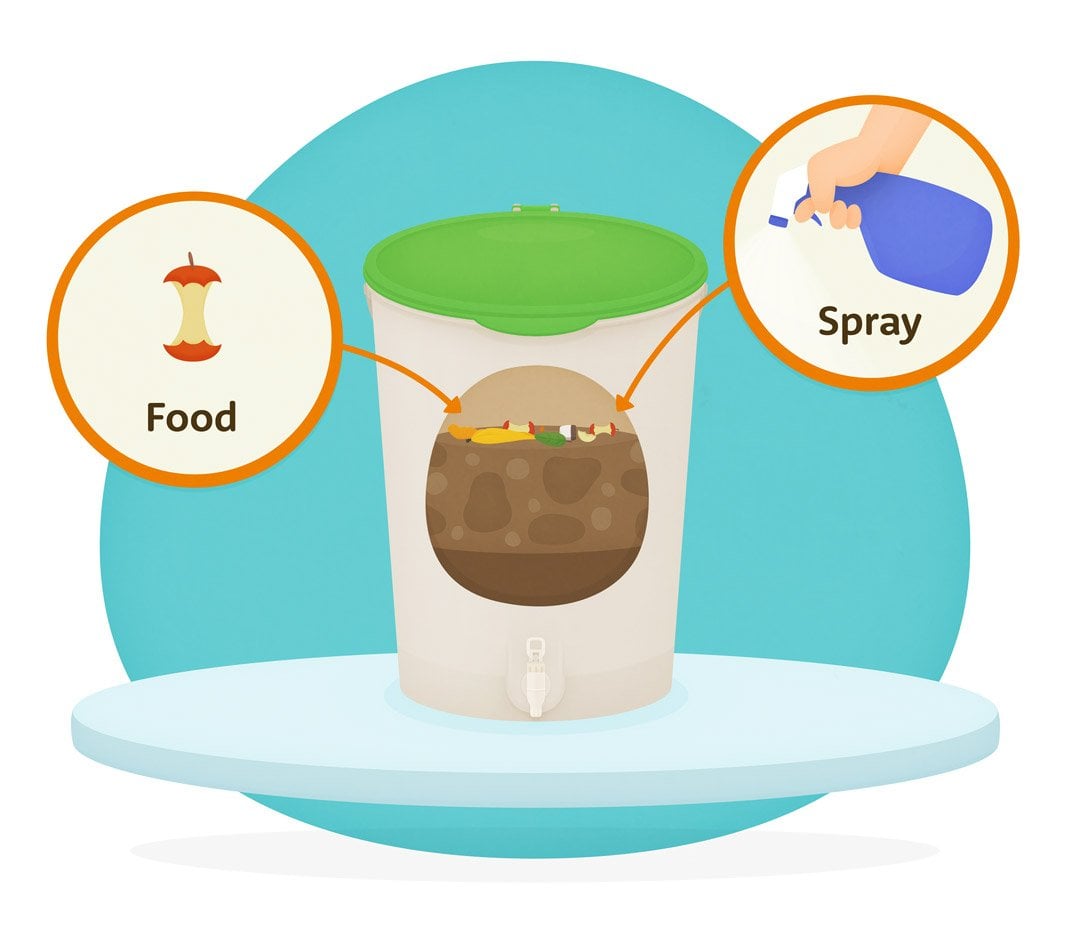Scegli un metodo
Choose whether a compost bin, worm farm, or bokashi bin is right for you based on your volume and type of food/garden waste, available space, and budget.
If you would like help choosing your product, click on the chat bot button right and select Send Message.

The different composting systems all accelerate nature's natural processes by heating up the compost and concentrating the microbes into a confined space.
Composting systems vary in what they recycle, including all types of organic waste such as food, paper, cardboard and garden materials. They all process larger volumes, making them suitable for households with a lot of food and/or garden waste.
Traditional (also known as above ground) compost bins need to be placed on soil. As the scraps break down, nutrient-rich liquid will disperse into the surrounding soil leaving rich compost to be harvested from the bottom every 6-12 months. They require regular (twice weekly) turning with an aerator.
Tumbling composters sit off the ground and can be placed anywhere, including balconies. The liquid from this process drips out and can be harvested or allowed to soak into the ground below. They require regular rotation with a hand crank or by rotating the drum directly, and produce rich compost in around 3-6 months (a little faster than traditional systems).
Solar composters are partially dug into the ground and capture more heat from the sun which aerates the compost without the need to turn it. So, they are faster than the other two systems and require less maintenance. They do not compost garden organics but do process all kinds of food waste and even pet poo!
Reclama il tuo sconto

Works by accelerating nature’s natural process of breaking down organic waste into a rich nourishing compost, teeming with life and a supercharger for your garden.
Composting systems recycle all types of organic waste including food, paper, cardboard and garden materials. This makes them perfect for larger households.
Open-bottom units need to be placed on soil. As the scraps break down nutrient-rich liquid will disperse into the surrounding soil. After ~6 months compost can be harvested from the bottom.
Reclama il tuo sconto

Works by aerobic decomposition, using the sun’s energy to break down food scraps into nutrients that are dispersed by worms and leaching liquids, which nourishes the surrounding soil.
Zero waste. Zero maintenance. Solar boosted composter.
The Green Cone recycles all types of food waste (including meat, dairy, bread and small bones) as well as small amounts of pet poo (not recommended if it is installed near food crops!). Designed to naturally circulate oxygen, there is no need for regular aeration making it perfect for medium to large households looking for a low-maintenance solution.
The system needs to be buried in well-draining soil, with full sun exposure for most of the day. As the food scraps break down, nutrient-rich liquid will disperse into the surrounding soil. No harvestable compost is produced.
Reclama il tuo sconto

Works by accelerating nature’s natural process of breaking down organic waste into a rich nourishing compost, teeming with life and a supercharger for your garden.
Composting systems recycle all types of organic waste including food, paper, cardboard and garden materials. This makes them perfect for larger households.
Tumblers sit off the ground and can be placed anywhere, including balconies. As the scraps break down nutrient-rich liquid will drain from the tumbler and can be collected to fertilise your garden. After one chamber is full you can let the compost mature whilst filling the other. After ~6 months you can harvest the mature compost.
Reclama il tuo sconto

Works with the help of wriggly warriors who chew through your food scraps, producing nutrient-rich worm castings and liquid fertiliser.
Worm farms recycle fruit and vegetables scraps, excluding citrus, onion, garlic and chilli.
The units can be placed indoors or outdoors, in a sheltered location out of the wind, rain and direct sunlight.
With a little tender loving care, worms will chew through your food scraps to produce nutrient-rich worm castings which can be harvested every 2-6 months. Liquid fertiliser also flows out of the farm on a regular basis, which can be diluted 10 to 1 with water to create free organic fertiliser for your garden.
Choose from the Farm, our compact, stylish award-winning worm farm made here by the Compost Revolution in Melbourne, Australia, or the large capacity Hungry Bin, made in New Zealand and ready to much through 2L of good a day!
Reclama il tuo sconto

A special culture of beneficial, naturally occurring microorganisms (EM) ferment food waste in anaerobic conditions, producing liquid fertiliser and fermented scraps.
Bokashi systems ferment all types of food waste (including meat, dairy, bread and small bones). The unit can be placed indoors or outdoors, in a cool location.
Food waste is added then mashed down to remove air pockets, followed by a spray of enzyme or handful of enzyme grain. Effective microorganisms (EM) then ferment food waste in anaerobic conditions.
Liquid fertiliser needs to be tapped every few days. Once the unit is full, the scraps are left to ferment for 1-2 weeks before being added to a compost bin or buried in soil. Fermented scraps will break down in 2-3 weeks in the soil delivering rich nutrients to surrounding plants.
Reclama il tuo sconto
Compost bins retain heat to speed up the process via above ground, partially buried, or rotating chambers.
- Processes lots of food scraps (limit meat and diary).
- Above ground and tumblers compost garden waste too.
- Low maintenance.
Produces rich harvestable compost for your garden and the sourrounding soil, plus tumblers produce liquid fertiliser.
See benefits
I lombrichi in un allevamento di lombrichi scompongono gli scarti alimentari nutrendosi dei microrganismi che mangiano il vostro cibo. Gli allevamenti di lombrichi vanno bene per appartamenti e piacciono ai bambini. Gli allevamenti di lombrichi devono essere posizionati in un luogo protetto e sono in grado di smaltire quantità inferiori di materiali rispetto ad un bidone del compostaggio. Anche la varietà di materiale che puoi aggiungere ad un allevamento di lombrichi è più limitata rispetto ad un bidone per il compostaggio.
Scegli un allevamento di lombrichi se:
- non hai un approvvigionamento continuo di scarti del giardinaggio
- abiti in un appartamento e non hai accesso a terreno spoglio, sabbia o ghiaia su cui piazzare un bidone per il compostaggio
- hai un nucleo familiare di portata modesta (meno di 4 persone) o non produci notevoli quantità di scarti alimentari
I vantaggi di un allevamento di lombrichi sono:
- il fertilizzante liquido (che è il prodotto principale) proveniente dal tuo allevamento di lombrichi è facile da applicare al tuo giardino
- puoi tenere l’allevamento di lombrichi in un cortile, su un balcone o in uno spazio al coperto
See benefits
Il bokashi è un metodo di compostaggio che prevede di far fermentare gli avanzi di cibo in un secchio ermetico. Gli avanzi sono decomposti senza mandare cattivi odori o riempirsi di insetti. È perfetto per le case più piccole con uno spazio limitato.
Il compostaggio bokashi è l'ideale per te se:
- vivi in un appartamento
- lavori in un ufficio con una cucina
- hai un posto in cui potrai poi smaltire o compostare i fertilizzanti semisolidi (orto, compostiera o orto comunitario)
Il bokashi ha tanti vantaggi, ad esempio:
- non manda cattivi odori, il secchio può stare in cucina
- può smaltire carne, latticini, agrumi e cipolle, che i lombrichi non amano
- il fertilizzante liquido è facile da raccogliere
See benefits











